标签:des style blog http color os io strong
An extensible file system format for portable storage media is provided. The extensible file system format includes the specification of primary and secondary directory entry types that may be custom defined. The primary and secondary directory entry types can be further classified as critical and benign directory entries.
Generally described, there are a number of portable computing devices, such as digital still cameras, digital video cameras, media players, mobile phones, mobile computing devices, personal digital assistants, and the like that maintain data on a storage media, such as a portable storage media. The continued development of more complex portable computing devices and larger storage capacity portable storage media places a greater demand for flexibility on the file system format used on the storage media. Current file system format approaches can become deficient in that they may provide adequate flexibility for increasing storage size capacities and/or storage media applications.
An extensible file system format for portable storage media is provided. The extensible file system format includes the specification of primary and secondary directory entry types that may be custom defined. The primary and secondary directory entry types can be further classified as critical and benign directory entries.
In accordance with an aspect of the present invention, a computer-readable medium having computer-executable components for storing data is provided. The computer-readable components can include a boot parameters component for specifying boot parameters for a file system. The computer-readable components also include a file allocation table component for defining a file allocation table associated with the file system. Additionally, the computer-readable components include a primary directory entry component for specifying data in a root directory of the file system. Still further, the computer-readable components include at least one secondary entry component corresponding to the primary directory entry component. The secondary entry component defines defining meta data associated with the primary directory entry component. The primary and secondary directory entry components can be further classified as critical or benign.
In accordance with another aspect of the present invention, a computer-readable medium having computer-executable components for storing data is provided. The computer-readable components include a boot parameters component for specifying boot parameters for a file system. The computer-readable components also include a file allocation table component for defining a file allocation table associated with the file system. Still further, the computer-readable components include a root directory component for specifying data in a root directory of the file system. Additionally, the computer-readable components include at least extensible one meta data component corresponding to the root directory entry component. The meta data component defines meta data associated with the root directory component.
In an illustrative embodiment, a file system will not mount a volume for a critical primary or root directory entry that is not recognized. The file system can ignore benign primary directory entries, critical secondary directory entries and benign secondary directory entries that are not recognized.
This summary is provided to introduce a selection of concepts in a simplified form that are further described below in the Detailed Description. This summary is not intended to identify key features of the claimed subject matter, nor is it intended to be used as an aid in determining the scope of the claimed subject matter.
Generally described, the present invention relates to an extensible file system format and various processes associated with the extensible file system format. In an illustrative embodiment, the extensible file system format corresponds to an extensible file system format for portable storage media and various processes associated with the extensible file system format on the portable storage media. Although the present invention will be described with regard to a portable storage media file system format, one skilled in the relevant art will appreciate that the disclosed embodiments are illustrative in nature and should not be construed as limiting. Additionally, one skilled in the relevant art will appreciate that the data structures and data layouts used in the illustrative examples may require additional information related to performance, security, and the like.
FIGS. 1A-1C?are block diagrams illustrative of various operating environments?100?for the extensible file system format of the present invention. With reference to?FIG. 1A, in an illustrative embodiment, the extensible file system format is utilized to store data from a computing device, such as a mobile computing device?102, and a storage media, such as a portable storage media?104. In an illustrative embodiment, the mobile computing device?102?can correspond to any one of a variety of computing devices, including but not limited to, portable computing devices, mobile telephones, personal digital assistants, music players, media players. The portable storage media can also include, but is not limited to, hard drives, flash media, micro-drives and other storage media. In an illustrative embodiment, the extensible file system on the portable storage media104?does not have to include any type of executable or readable software components, such as an operating environment, utilized by the mobile computing device?102. Alternatively, the extensible file system on the portable storage media?104?may include executable or readable software components used by the mobile device?102.
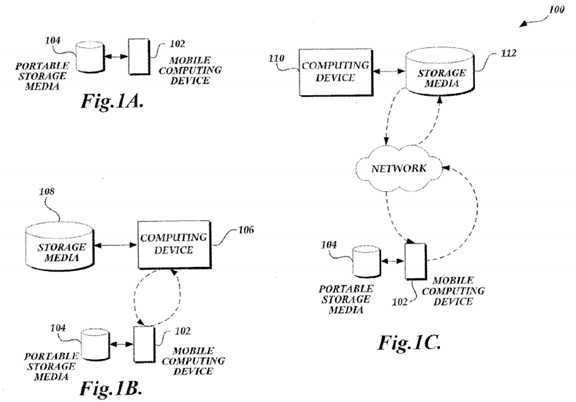
In an illustrative embodiment, the mobile computing device?102?may be in communication with other computing devices for collecting/exchanging data to be stored on the portable storage media?104. With reference to?FIG. 1B, the mobile computing device?102?may be in direct communication with another computing device?106?and storage media?108. In an illustrative embodiment, the direct communication can correspond to various wired and wireless communication methods. In an illustrative embodiment, the other storage media?108?is not required to be formatted in accordance with the extensible file system format of the present invention. With reference to?FIG. 1C, in a similar manner, the mobile computing device?102may also be in communication with another computing device?110?and storage media?112, via a network connection. In an illustrative embodiment, the network connection can correspond to local area network (LAN) and wide are network (WAN) connections.
With reference now to?FIG. 2, an illustrative embodiment volume layout?200?for an extensible file system format will be described. The volume layout?200?includes a boot parameters component?202?that include various information related to a description of the file system parameters of the partition. In an illustrative embodiment, the boot parameters component?202can include code for bootstrapping from a defined partition, fundamental file system parameters for the defined partition, and various error checking information. A data structure for defining at least a portion of the boot parameters will be described below with regard to?FIG. 4.
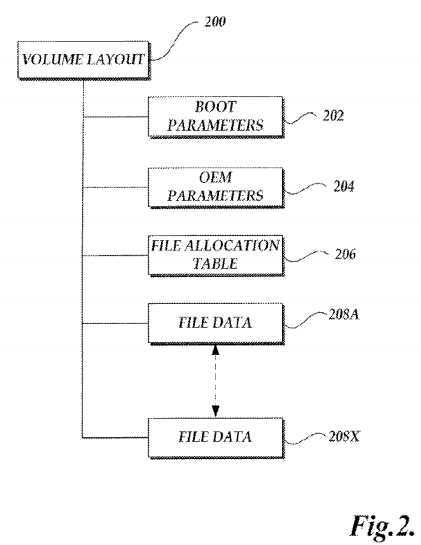
The volume layout?200?also includes an extensible parameters component, designated as OEM parameters?204, that define various additional data structures used in conjunction with the file system. In an illustrative embodiment, an original equipment manufacture (OEM) may specify various extensible data structures, such as performance parameters for a storage medium, that can be defined at time of manufacture. The volume layout?200?can further include a file allocation table component?206?that defines file and directory allocations. In an illustrative embodiment, each entry in the file allocation table component?206?corresponds to a 32-bit entry that represents an allocated cluster, an unallocated cluster or an unusable cluster. The volume layout?200?can still further include series of file data components?208A-208X that correspond to the data stored according to the file system format. Various data structures for defining a portion of the file data components?208A-208X will be defined with regard to?FIGS. 3-10.
Turning now to?FIG. 3, in one aspect, the file data components?208?may include one or more directory entries according to a directory structure?300. In an illustrative embodiment, directory structure?300?is organized into primary directory entries302?and secondary directory entries?304. Each directory entry in the primary and secondary entries is typed. For example, in an illustrative embodiment, type values for the primary and secondary directory entries can correspond to a range of 1-255. Primary directory entries?302?correspond to the entries in the root directory of the file system. Secondary directory entries?304?follow a primary directory entry and are associated with the primary directory entry. Secondary directory entries extend the metadata associated with the correlated primary directory entry.
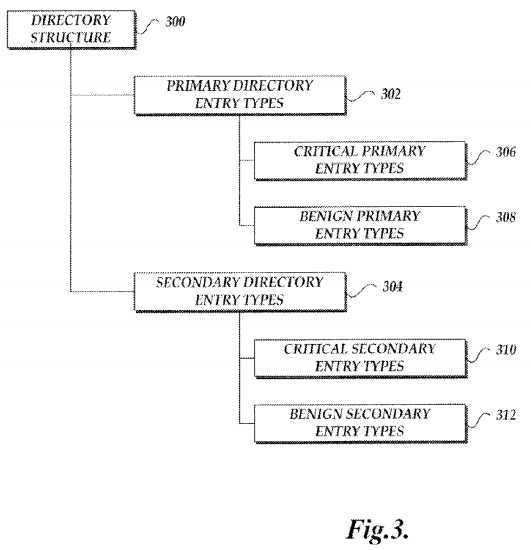
With continued reference to?FIG. 3, in an illustrative embodiment, the primary directory entries?302?can be further classified as critical primary directory entries?306?and benign primary directory entries?308. Critical primary directory entries?306 define potentially different formats for each directory entry. In an illustrative embodiment, an operating environment will not mount a volume corresponding to the extensible file system format with an unknown critical primary directory entry, as will be described below. Examples of known primary directory entries?306?can include allocation bitmaps, up-case tables, volume labels, encryption keys, and normal directory entries. Benign primary directory entries?308?also define potential different formats for each directory entry, but can be ignored by the file system if a particular benign primary directory entry is not understood. Benign primary directory entries?308?can be associated with another cluster chain the volume. Additionally, benign primary directory entries?308?can also be associated a number of secondary directory entries?304.
In a manner similar to primary directory entries?302, secondary directory entries?304?may also be further classified as critical secondary directory entries?310?and benign secondary directory entries?312. As described above, the critical secondary directory entries?310?and benign secondary directory entries?312?are associated with a benign primary directory entry and extend the metadata associated with the primary directory entry. Both the critical secondary directory entries?310 and the benign secondary directory entries?312?can be associated with another cluster chain the volume.
To mount a volume corresponding to the extensible file system format, the file system implements a mount volume procedure. In an illustrative embodiment, the mount volume procedure attempts to look at a version number for the volume. If the version number is not understood (e.g., the version number is higher), the volume will not be mounted. During a normal directory enumeration, any critical primary directory entries not known by the file system will prevent the volume from being mounted. Thereafter, various user-initiated processes, such as a file open, will cause the file system to enumerate the secondary directory entries. If the critical secondary directory entries?310?are not known by a file system, the entire directory entry will be skipped. Additionally, if benign secondary directory entries?312?are not known by the file system, the particular unknown benign secondary directory entry will be ignored.
With reference now to?FIG. 4, a block diagram illustrative of data components?400?for implementing a boot process block in the boot parameters component?202?(FIG. 2) will be described. The data components?400?include an OEM name component402?for specifying a name for the file system format of the storage media. The data components?400?also include a data size descriptor component?404?for specifying various characteristics of the data stored in the file system. For example, the data size descriptor component?404?can specify a count of bytes per sector, a number of sectors per allocation unit, a FAT table offset, and a count of sectors for all data structures. The data components include an active FAT flags component?406?for specifying a number of active FATs on the file system. In an illustrative embodiment, a file system may support multiple FATs for utilization with some operating system environments. The data components?400?can further include a volume identification component?408?for identifying a volume serial number and/or version number. Still further, the data components?400?can include a file system type for specifying the file system format for the file system. One skilled in the relevant art will appreciate that the data components?400?can include a number of additional/alternative rows for implementing the above-identified components?402-410?and additional components.
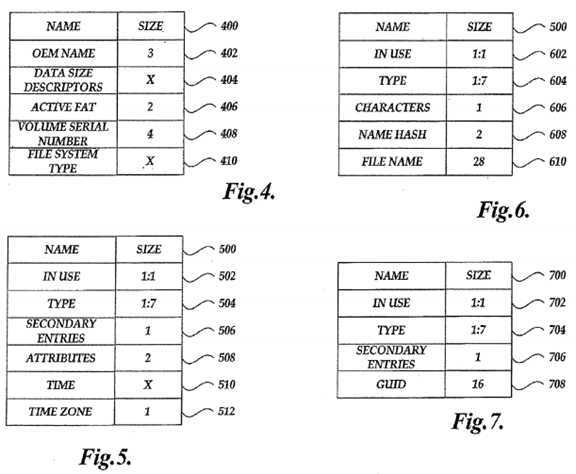
Turning now to?FIG. 5, a block diagram illustrative of data components?500?for implementing directory entries in an extensible file system format will be described. The data components?500?include an in use component?502?for specifying whether the particular directory entry is in use. In an illustrative embodiment, the high bit of the data components will be set to "1" if the directory entry is in use. The data components?500?further include a type designation component?504?for specifying that the directory entry is associated with a normal directory entry. The data components?500?further include a secondary directory entries component?504?for specifying a number of secondary entries associated with the normal directory entry. The data components?500?also include a file attributes component?508?for specifying various file system attributes for the directory entry. Still further, the data components?500?include a time component?510?for specifying various time information such as a creation timestamp, modification time stamp and other time information. Additionally, the data components?500?further include a time zone component?512?for specifying a time zone for the last created time stamp. One skilled in the relevant art will appreciate that the data components?500?can include a number of additional/alternative rows for implementing the above-identified components?502-512?and additional components.
Turning now to?FIG. 6, a block diagram data components?600?for implementing a file name and extensions will be described. The data components?600?include an in use component?602?for specifying whether the particular directory entry is in use. In an illustrative embodiment, the high bit of the data components will be set to "1" if the directory entry is in use. The data components?600?further include a type designation component?604?for specifying that the directory entry is associated with a file system name. The data components further include a file name length component?606?and a file name has component608. The utilization of the file name hash component?608?will be described below. The data components?600?also include a file name component?610?for specifying the file name. One skilled in the relevant art will appreciate that the data components600?can include a number of additional/alternative rows for implementing the above-identified components?602-610?and additional components. Additionally, file name directory entries may be extended by secondary directory entries.
Turning now to?FIG. 7, a block diagram illustrative of data components?700?for implementing a volume identifier in an extensible file system format is provided. The data components?700?include an in use component?702?for specifying whether the particular directory entry is in use. In an illustrative embodiment, the high bit of the data components will be set to "1" if the directory entry is in use. The data components?700?further include a type designation component?704?for specifying that the directory entry is associated with a volume identifier. The data components?700?further include a secondary directory entries component?706?for specifying a number of secondary entries associated with the volume identifier. The data components?700?also include a volume identifier?708, such as a global unique identifier. One skilled in the relevant art will appreciate that the data components?700?can include a number of additional/alternative rows for implementing the above-identified components?702-708?and additional components. Additionally, in an illustrative embodiment, the data components700?correspond to a benign directory entry that can be ignored by a file system that does not support volume identifiers.
With reference now to?FIGS. 8 and 9, in an illustrative embodiment, parties, such as an OEM, may be able to define specific benign primary directory entry types?308?and benign secondary directory entry types?312. As discussed above, in the event the file system would not recognize or understand either the specific benign primary directory entry types?308?or benign secondary directory entry types?312, the file system could ignore the defined directory entry types.
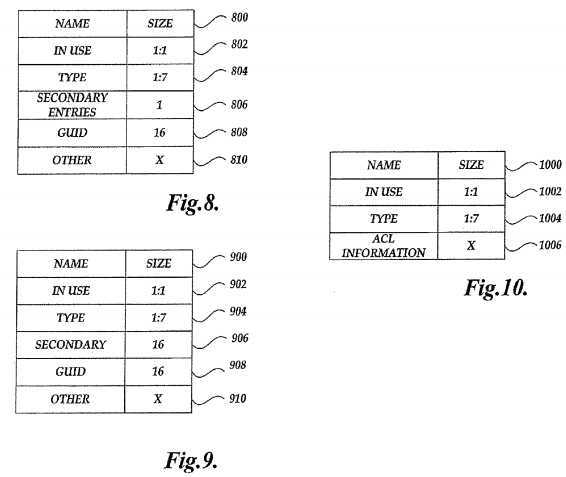
With reference to?FIG. 8, a block diagram illustrative of data components?800?for implementing an extensible benign primary directory entry?308?in an extensible file system format will be described. The data components?800?include an in use component?802?for specifying whether the particular directory entry is in use. In an illustrative embodiment, the high bit of the data components will be set to "1" if the directory entry is in use. The data components?800?further include a type designation component?804?for specifying that the directory entry is a benign primary directory entry. The data components800?further include a secondary directory entries component?806?for specifying a number of secondary entries associated with the volume identifier. The data components?800?also include a volume identifier?808, such as a global unique identifier. The data components?800?can further include additional information?810, such as verification information and a starting cluster. One skilled in the relevant art will appreciate that the data components?800?can include a number of additional/alternative rows for implementing the above-identified components?802-506?and additional components.
With reference to?FIG. 9, a block diagram illustrative of data components?900?for implementing a benign secondary directory entry in an extensible file system format will be described. The data components?900?include an in use component902?for specifying whether the particular directory entry is in use. In an illustrative embodiment, the high bit of the data components will be set to "1" if the directory entry is in use. The data components?900?further include a type designation component?904?for specifying that the directory entry is a benign primary directory entry. The data components?900?further include a secondary directory entries component?906?for specifying a number of secondary entries associated with the volume identifier. The data components?900?also include a volume identifier?908, such as a global unique identifier. The data components?900?can further include additional information?910, such as verification information and a starting cluster. One skilled in the relevant art will appreciate that the data components?900?can include a number of additional/alternative rows for implementing the above-identified components?902-906?and additional components.
In an illustrative embodiment, a benign primary directory entry and/or secondary directory entries may be associated with access control list (ACL) information.?FIG. 10?is a block diagram illustrative of data components?1000?for implementing an access control list in an extensible file system format. The data components?1000?include an in use component?1002?for specifying whether the particular directory entry is in use. In an illustrative embodiment, the high bit of the data components will be set to "1" if the directory entry is in use. The data components?1000?further include a type designation component1004?for specifying that the directory entry is an ACL directory entry. The data components?1000?further include a number of ACL fields?1006, such as ACL flags, pointers to ACL databases, and the like. One skilled in the relevant art will appreciate that the data components?1000?can include a number of additional/alternative rows for implementing the above-identified components?1002-1006?and additional components.
With reference now to?FIG. 11, a file name creation routine?1100?for an extensible file system format will be described. At block?1102, a file system obtains a request to create a directory entry with a specific file name. In an illustrative embodiment, the specific file name can correspond to a naming convention, such as a digital camera picture naming convention. At block?1104, the file system generates a target name hash. At block?1106, an iterative loop is begun by examining the next directory entry hash value. An illustrative directory entry type for storing directory entry hash values is described above with regard to data components?600?(FIG. 6).
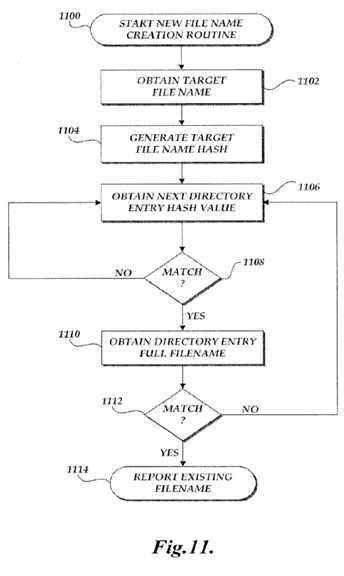
At decision block?1108, a test is conducted to determine whether the target hash value matches the current directory entry hash value. If they do not match, the routine?1100?returns to block?1106?(until all the directory entries have been examined). If the hash values match at decision block?1108, at block?1110, the file system obtains the full file name for the potentially matching directory entry. An illustrative directory entry type for storing directory entry full file names is described above with regard to data components?600?(FIG. 6). At decision block?1112, a test is conducted to determine whether the target file name matches the full file name of the potentially matching directory entry. If so, the routine?1100?terminates by reporting a conflict and the file system will be required to select a new file name. If the full file does not match, the routine?1100?will return to block?1106?to continue checking hash values for all the directory entries in the file system.
In accordance with an aspect of the present invention, various additional functionality may be added through the specification of specific directory types. For example, name streams may be supported by specifying a name stream directory entry. Additionally, on-disk encryption may also be supported through the utilization of specific encryption algorithms and key exchanges. Still further, time zone conversions may be associated with directory entries to automatically convert a current time zone with a time zone with the directory entry was made.
While illustrative embodiments have been illustrated and described, it will be appreciated that various changes can be made therein without departing from the spirit and scope of the invention.
SRC=https://www.google.com/patents/US20140067885
Extensible File System,布布扣,bubuko.com
标签:des style blog http color os io strong
原文地址:http://www.cnblogs.com/coryxie/p/3895127.html